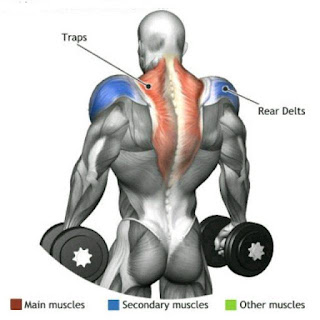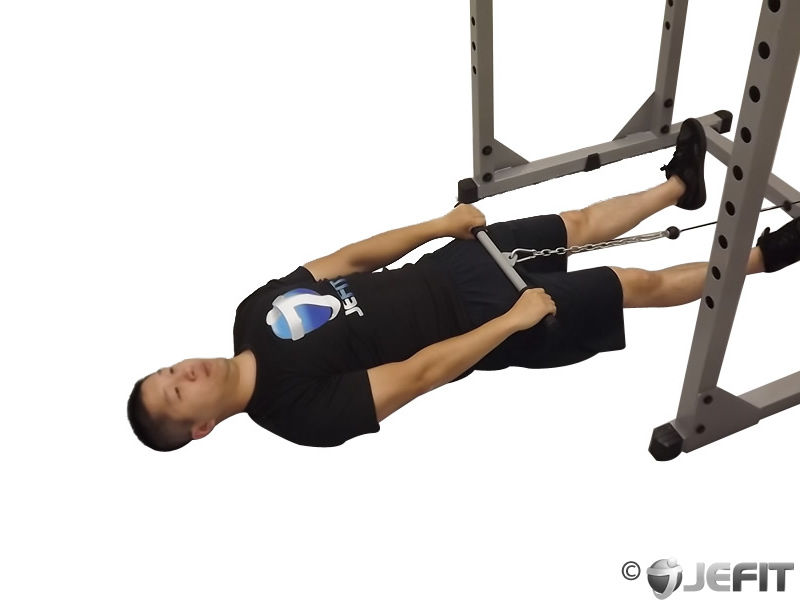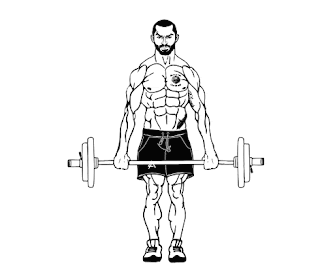What are shrugs?
Shrugs are a resistance training exercise that work the trapezius muscle in the upper back and they are exactly as the name suggests, a 'shrugging' movement. There are not many exercises that directly target the trap muscles making the shrug a great exercise to add to your split.
Shrugs can be performed with various grips, stances, and equipment. In this article, we will go on to depth about the different shrug exercises available, the advantages of each one, and how to perform them correctly. If you are looking to grow your traps, read on...
Which muscle is targeted with a shrug?
The trapezius muscle is the main target when performing a shrug. It is the muscle in your upper back which starts between the shoulders and neck and goes down between the rhomboids.
It is used for most rowing exercises as well as deadlifts, but only as a secondary target. Shrugs are the best way to develop muscle for both hypertrophy and strength.
When performed correctly, the only other activated muscles should be in the forearm and the neck. If you bend your arms, you will be activating the biceps and deltoids which will take resistance away from the traps.
If you are lifting heavy in a standing position, you will be employing muscles in your trunk as stabilisers. The only way to avoid this is either by using a bench and opting for dumbbell shrugs or laying on your back to perform cable shrugs.
How do I do shrugs?
Shrugs are a fairly simple exercise to perform, but there are a lot of different methods which can cause confusion. Try to experiment with some of the below examples until you find one that really allows you to connect with the muscle. It is also worth hitting shrugs from different angles and with different grips.
An 'upwards shrug will target the upper traps giving you definition in your shoulders, upper chest and upper back. A lateral shrug will add thickness to your mid traps adding mass and mid-back definition. By using both of these movements, you will be getting maximum growth from your traps.
How do I do a cable shrug?
Cable machines are great for shrugs. They provide constant resistance, smooth motion, and different grip options. They also have the added advantage of being adjustable so it is easy to change the pulley height or weight.
There are a few different ways of performing shrugs on a cable machine, but they all include the same 'shrugging' movement. The easiest method is on a single station with a straight bar.
- Set the pulley at a low pin and select your weight on the stack. Attach a straight bar and pick it up with an overhand grip.
- Stand with your feet slightly apart and knees slightly bent for stability. Keep your back straight with the bar held against your upper thighs. This is your starting position.
- Without bending your arms or bouncing at the knees, pull the bar up to your abdomen with a shrugging motion.
- Hold this movement at the top and squeeze your trap muscles for a few seconds,
- Slowly lower the bar back to the starting position,
- Repeat this movement for the required number of reps and sets.
Some useful tips.
Instead of focusing on heavy weight, try holding the shrug for 8-10 seconds before lowering with a slow negative. By doing this for the first few reps of a set and then 'pumping' the traps until failure, you can focus on form and connection. You will also be breaking down different fibres within the muscle, allowing for more growth.
It is also wise to experiment with different bars and grips. The benefit of using a cable station is that you can use an EZ bar, wide-grip straight bar or a hammer-grip bar. By changing your grip method and width, you will target different fibres within the traps.
If you are lucky enough to have a twin cable station at your gym, you can load a stirrup on each side and really work the traps. This is an ideal method if you are an advanced lifter and want to train with a heavy load. Your grip will usually give out long before your traps so it is worth wearing wrist straps or hooks if you have them.
Standing shrugs are the popular option, but if you find yourself cheating the movement, try lying on your back with your feet against the bottom of the cable station. You can then perform the same movement but really isolate your traps without bending the knees or hingeing at the waist.
How do I do barbell shrugs?
The good old barbell is another great option for performing shrugs. It is easier to perform with a rack as it allows you to load the bar easily and start the weight off at waist height. If you lift your bar from the floor, make sure you are using the proper technique and your lower back is supported.
The movement is the same as detailed in the cable shrug above. A shoulder-width grip is the standard, but using a wide grip for variety occasionally will hit the muscle from a different angle and promote growth. A variation of a barbell shrug can also be performed on a smith machine.
Using a smith machine can make loading weights easy and give you a smooth, supported motion, but you may find it restricts you from keeping the weight close enough to really connect with your traps.
How do I do trap bar shrugs?
If you are planning on hitting shrugs with free weights, the trap bar (also known as the hex bar) is one of the best options available. It allows you to hit traps with a neutral grip and really connect with the muscle.
If your trap bar has legs, stand it on the floor, load it up, step inside, and shrug away. If it doesn't, it is wise to use a rack at a low level. This allows you to load the bar with ease and prevents you from having to lift the bar from the ground. The trap bar is a great option if you plan to lift heavy.
Just remember to use wrist straps so that you can put all of your focus on training to failure and not just keeping hold of the bar.
How do I do dumbbell shrugs?
Some lifters swear by dumbbells for big traps. Being able to hold the weight at a neutral, comfortable grip and having a bit of flexibility in the movement can be of some considerable benefit.
Using dumbbells allows you to roll the shoulders backwards slightly as you shrug, which can really help you connect to the muscle.

Another advantage of using a dumbbell is that you can perform the shrug in a seated position. By using a dumbbell bench in a fully inclined position, you can eliminate your core stabiliser muscles from the movement and reduce any 'cheat' in the motion.
How do I do lateral shrugs?
Lateral shrugs are similar to standard shrugs, but instead of shifting the weight in an upwards motion, you are pulling it towards you. Lateral shrugs can be performed on a cable machine, row machine or by lying face down on an incline bench and 'shrugging' a weight up towards you.
When performing lateral shrugs, start with the bar out in front of you and an overhand grip. Keeping a straight spine and straight arms, shrug the bar towards you and squeeze the traps.
Make sure you are connecting only to your traps and not your lats or rear delts. If you can't feel the connection with your traps, use a lighter weight and squeeze at the top of the movement.
This is a great way of adding thickness to the traps and definition in the upper back. It is often overlooked by many bodybuilders and strength trainers as they believe that this part of the trap gets a good enough workout with deadlifts and rows but lateral shrugs will break down fibres that these movements will not.
Alternatives to shrugs.
There are no real substitutes for shrugs if you want to directly target the trapezius muscles. Some other movements will activate the traps as secondary movers and, if you are genetically gifted, promote enough growth to not need shrugs. these are...






